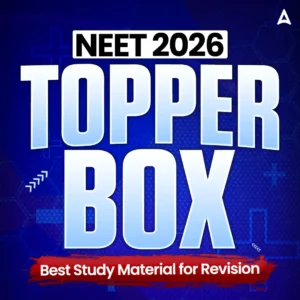While preparing for the NEET UG Exam 2026, students are required to prepare for all the subjects, and Physics is one of them. Therefore, it is required that they study for all the topics mentioned in the NEET Physics Syllabus 2026. Majorly, the NEET Syllabus for the Physics Exam covers all the concepts covered in the Class 11th and Class 12th Physics syllabus.
To finalize their preparations for the exam, aspirants need to have knowledge of the chapter-wise weightage and important topics, along with the exam pattern and other important factors. Scroll down in the article below to check the NEET Physics Syllabus 2026 and other important factors required for the exam preparation.
NEET Physics Syllabus 2026
The NEET Physics syllabus includes key topics. Mechanics studies motion, forces, and energy. Thermodynamics focuses on heat, work, and energy transfer. Optics explains how light works, like reflection and refraction. Electricity deals with electric fields, circuits, and currents, while Magnetism covers magnetic fields and electromagnetic waves. Modern Physics introduces ideas like quantum mechanics and nuclear physics. Other important topics include kinematics, waves, and electromagnetic induction. The syllabus follows the latest NCERT Physics textbooks and is designed by the NTA (National Testing Agency).
NEET Physics Syllabus 2026 Chapters
The NEET Physics syllabus for 2026 will be designed to test students’ understanding of different concepts about the physical world and natural events. It covers important topics such as Mechanics, which involves motion; Electrodynamics, which deals with electricity and magnetism; Thermodynamics, focused on heat and energy; Optics, related to light; and Modern Physics, which includes advanced topics.
By studying these areas, students can prepare well for the NEET exam and demonstrate their knowledge in physics. Below are the chapter topics included in the NEET Syllabus 2026 for Physics. These chapters help us understand natural laws and principles, essential for medical entrance exams.
| NEET Syllabus for Physics | |
| 1 | Physics and measurement |
| 2 | Kinematics |
| 3 | Laws of Motion |
| 4 | Work, Energy, and Power |
| 5 | Rotational Motions |
| 6 | Gravitation |
| 7 | Properties of Solids and Liquids |
| 8 | Thermodynamics |
| 9 | Kinetic Theory of Gases |
| 10 | Oscillations and wave |
| 11 | Electro statistics |
| 12 | Current Electricity |
| 13 | Magnetic effects of Current and Magnetism |
| 14 | Electromagnetic induction and alternating currents |
| 15 | Optics |
| 16 | Dual Nature of Matter and Radiation |
| 17 | Atoms and Nuclei |
| 18 | Electronic Devices |
| 19 | Experimental Skills |
NEET Physics Syllabus 2026 Chapter Wise Weightage
Knowing how many marks each chapter carries helps you study better. You can focus more on important topics to score well. It also helps you plan your time and cover everything. When you understand the exam pattern, you can prepare wisely by spending more time on key chapters. This way, you won’t miss anything important. Studying like this makes learning easier and improves your chances of getting good marks. Smart preparation helps you feel confident and ready for the exam, making it easier to do your best.
| NEET Physics Syllabus 2026 Chapter Wise Weightage | |
| Name of the chapter | Weightage in percentile |
| Current electricity | 8 |
| Dual Nature of Radiation and Matter | 6 |
| Electromagnetic induction | 4 |
| Alternating current | 4 |
| Atoms | 1.5 |
| Electromagnetic waves | 5 |
| Electric Charges and Fields | 4.5 |
| Electrostatic Potential and Capacitance | 4.5 |
| Gravitation | 2 |
| Kinetic theory | 3 |
| Mechanical Properties of Fluids | 2 |
| Work, Energy, and Power | 4 |
| Mechanical Properties of Solids | 2 |
| Newton’s Laws of Motion | 3 |
| Magnetism and Matter | 2.5 |
| Motion in a Plane | 1.5 |
| Motion in a Straight Line | 1.5 |
| Moving Charges and Magnetism | 2.5 |
| Nuclei | 1.5 |
| Oscillations | 1.5 |
| Physical World, Units, and Measurements | 2 |
| Ray optics and optical instruments | 5 |
| Thermal Properties of Matter | 2 |
| Thermodynamics | 9 |
| Semiconductor Electronics: Materials, Devices, and Simple Circuits | 6 |
| System of Particles and Rotational Motion | 5 |
| Wave optics | 5 |
| Waves | 1.5 |
| Total | 100 |
Detailed NEET Physics Syllabus 2026 Class 11
This NEET Physics syllabus for Class 11 in 2026 outlines key topics you need to study for the exam, including Mechanics, Thermodynamics, Waves, and Optics. For Class 11 students aiming to excel in NEET, this simplified syllabus provides a strong foundation in essential physics concepts. By focusing on these core areas, you can build the knowledge necessary to perform well on the test. Early and thorough preparation using this syllabus will help you understand the material better and boost your confidence for the exam.
| NEET Physics Syllabus 2026: Class 11th | |
| Units | Chapters |
| Unit 1: Physics and Measurement | Units of measurement, System of Units, S I Units, fundamental and derived units, least count, significant figures, Errors in measurements, Dimensions of Physics quantities, dimensional analysis, and its applications. |
| Unit 2: Kinematics | The frame of reference, motion in a straight line, Position- time graph, speed and velocity; Uniform and non-uniform motion, average speed and instantaneous velocity, uniformly accelerated motion, velocity-time, position-time graph, relations for uniformly accelerated motion, Scalars and Vectors, Vector. Addition and subtraction, scalar and vector products, Unit Vector, Resolution of a Vector, Relative Velocity, Motion in a plane, Projectile Motion, and Uniform Circular Motion. |
| Unit 3: Laws of Motion | Force and inertia, Newton’s First Law of motion; Momentum, Newton’s Second Law of motion, Impulses: Newton’s Third Law of motion. Law of conservation of linear momentum and its applications. Equilibrium of concurrent forces.
Static and Kinetic friction, laws of friction, rolling friction. Dynamics of uniform circular motion: centripetal force and its applications: Vehicle on a level circular road, vehicle on a banked road |
| Unit 4: Work, Energy and Power | Work done by a constant force and a variable force; kinetic and potential energies, work-energy theorem, power.
The potential energy of spring conservation of mechanical energy, conservative and non-conservative forces; motion in a vertical circle: Elastic and inelastic collisions in one and two dimensions. |
| Unit 5: Rotational Motion | Centre of the mass of a two-particle system, Centre of the mass of a rigid body; Basic concepts of rotational motion; moment of a force; torque, angular momentum, conservation of angular momentum and its applications;
The moment of inertia, the radius of gyration, values of moments of inertia for simple geometrical objects, parallel and perpendicular axes theorems, and their applications. Equilibrium of rigid bodies, rigid body rotation and equations of rotational motion, comparison of linear and rotational motions. |
| Unit 6: Gravitation | The universal law of gravitation. Acceleration due to gravity and its variation with altitude and depth. Kepler’s law of planetary motion. Gravitational potential energy; gravitational potential. Escape velocity, Motion of a satellite, orbital velocity, time period, and energy of satellite. |
| Unit 7: Properties of Solids and Liquids | Elastic behavior, Stress-strain relationship, Hooke’s Law. Young’s modulus, bulk modulus, and modulus of rigidity. Pressure due to a fluid column; Pascal’s law and its applications. Effect of gravity on fluid pressure.
Viscosity. Stokes’ law. terminal velocity, streamline, and turbulent flow. critical velocity Bernoulli’s principle and its applications. Surface energy and surface tension, angle of contact, excess of pressure across a curved surface, application of surface tension – drops, bubbles, and capillary rise. Heat, temperature, thermal expansion; specific heat capacity, calorimetry; change of state, latent heat. Heat transfer-conduction, convection, and radiation. |
| Unit 8: Thermodynamics | Thermal equilibrium, zeroth law of thermodynamics, the concept of temperature. Heat, work, and internal energy. The first law of thermodynamics, isothermal and adiabatic processes. The second law of thermodynamics: reversible and irreversible processes. |
| Unit 9: Kinetic Theory of Gases | Equation of state of a perfect gas, work done on compressing a gas, Kinetic theory of gases – assumptions, the concept of pressure. Kinetic interpretation of temperature: RMS speed of gas molecules: Degrees of freedom. Law of equipartition of energy and applications to specific heat capacities of gases; Mean free path. Avogadro’s number. |
| Unit 10: Oscillations and Waves | Oscillations and periodic motion – time period, frequency, displacement as a function of time. Periodic functions. Simple harmonic motion (S.H.M.) and its equation; phase: oscillations of a spring -restoring force and force constant: energy in S.H.M. – Kinetic and potential energies;
Simple pendulum – derivation of expression for its time period: Wave motion. Longitudinal and transverse waves, speed of traveling wave. Displacement relation for a progressive wave. Principle of superposition of waves, reflection of waves. Standing waves in strings and organ pipes, fundamental mode and harmonics- Beats. |
NEET Physics Syllabus 2026 PDF Download Link
The National Testing Agency (NTA) will soon open the official link to check and download the latest Physics syllabus for NEET 2026. The updated Physics syllabus is available on the official NEET website – www.neet.nta.nic.in. Students preparing for NEET UG 2026 will be able to view or download the syllabus easily. A direct link to the NEET 2026 Physics syllabus will also be provided in the article below. This will help students get the correct topics to study for the exam. Keep checking the website or the link in the article for the latest updates.
Detailed NEET Physics Syllabus 2026 Class 12
The NEET 2026 Physics syllabus for Class 12 might include important topics like Electrostatics, Magnetism, Optics, and Modern Physics. These topics help students understand advanced physics concepts needed for the NEET exam. The syllabus covers key principles in a simple and structured way, making it easier for students to prepare.
By studying these topics, students can build a strong foundation in physics, which is essential for scoring well in NEET. Understanding these concepts will help students solve questions confidently and perform better in the exam. With proper preparation, they can improve their problem-solving skills and increase their chances of success in NEET 2026.
| NEET Physics Syllabus 2026: Class 12th | |
| Units | Chapters |
| Unit 11: Electrostatics | Electric charges: Conservation of charge, Coulomb’s law forces between two point charges, forces between multiple charges: superposition principle and continuous charge distribution.
Electric field: Electric field due to a point charge, Electric field lines, Electric dipole, Electric field due to a dipole, Torque on a dipole in a uniform electric field. Electric flux. Gauss’s law and its applications to find field due to infinitely long uniformly charged straight wire uniformly charged infinite plane sheet, and uniformly charged thin spherical shell. Electric potential and its calculation for a point charge, electric dipole and system of charges; potential difference, Equipotential surfaces, Electrical potential energy of a system of two point charges and of electric dipole in an electrostatic field. Conductors and insulators. Dielectrics and electric polarization, capacitors, and capacitances, the combination of capacitors in series and parallel, capacitance of a parallel plate capacitor with and without dielectric medium between the plates, Energy stored in a capacitor. |
| Unit 12: Current Electricity | Electric current, Drift velocity, mobility and their relation with electric current, Ohm’s law. Electrical resistance, V-L characteristics of ohmic and non-ohmic conductors, Electrical energy and power. Electrical resistivity and conductivity, Series and parallel combinations of resistors; Temperature dependence of resistance.
Internal resistance, potential difference and emf of a cell, a combination of cells in series and parallel, Kirchhoff’s laws and their applications, Wheatstone bridge, Metre Bridge. |
| Unit 13: Magnetic Effects of Current and Magnetism | Biot – Savart law and its application to current carrying circular loop, Ampere’s law, and its applications to infinitely long current carrying straight wire and solenoid, Force on a moving charge in uniform magnetic and electric fields.
Force on a current-carrying conductor in a uniform magnetic field. The force between two parallel currents carrying conductors-definition of ampere. Torque experienced by a current loop in a uniform magnetic field: Moving coil galvanometer, its sensitivity, and conversion to ammeter and voltmeter. Current loop as a magnetic dipole and its magnetic dipole moment. Bar magnet as an equivalent solenoid, magnetic field lines; Magnetic field due to a magnetic dipole (bar magnet) along its axis and perpendicular to its axis. Torque on a magnetic dipole in a uniform magnetic field. Para-, dia- and ferromagnetic substances with examples, effect of temperature on magnetic properties. |
| Unit 14: Electromagnetic Induction and Alternating Currents | Electromagnetic induction: Faraday’s law, Induced emf and current: Lenz’s Law, Eddy currents. Self and mutual inductance. Alternating currents, peak and RMS value of alternating current/ voltage: reactance and impedance: LCR series circuit, resonance: power in AC circuits, wattless current. AC generator and transformer. |
| Unit 15: Electromagnetic Waves | Displacement current, Electromagnetic waves and their characteristics, Transverse nature of electromagnetic waves, Electromagnetic spectrum (radio waves, microwaves, infrared, visible, ultraviolet, X-rays, Gamma rays), Applications of em waves. |
| Unit 16: Optics | Reflection of light, spherical minors, mirror formula, Refraction of right at plane and spherical surfaces, thin lens formula and lens maker formula, Total internal reflection and its applications.
Magnification, Power of a Lens, Combination of thin lenses in contact, Refraction of light through a prism, Microscope and Astronomical Telescope (reflecting and refracting ) and their magnifying powers. Wave optics: wavefront and Huygens’ principle, Laws of reflection and refraction using Huygens principle, Interference, Young’s double-slit experiment and expression for fringe width, coherent sources, and sustained interference of light, Diffraction due to a single slit, width of central maximum, Polarization, plane-polarized light: Brewster’s law, uses of plane-polarized light and Polaroid. |
| Unit 17: Dual Nature of Matter and Radiation | Dual nature of radiation, Photoelectric effect, Hertz and Lenard’s observations; Einstein’s photoelectric equation: particle nature of light, Matter waves-wave nature of particle, de Broglie relation. |
| Unit 18: Atoms and Nuclei | Alpha-particle scattering experiment; Rutherford’s model of atom; Bohr model, energy levels, hydrogen spectrum, Composition and size of nucleus, atomic masses, Mass-energy relation, mass defect; binding energy per nucleon and its variation with mass number, nuclear fission, and fusion. |
| Unit 19: Electronic Devices | Semiconductors; semiconductor diode: I-V characteristics in forward and reverse bias; diode as a rectifier; I-V characteristics of LED, the photodiode, solar cell, and Zener diode; Zener diode as a voltage regulator, Logic gates (OR, AND, NOT, NAND and NOR). |
| Unit 20: Experimental Skills | Familiarity with the basic approach and observations of the experiments and activities:
|
NEET 2026 Physics Syllabus: Important Topics
Knowing the important topics for exams helps students focus on the most necessary parts of their studies. When students study key concepts, they can manage their time better and understand the subject more easily. This method allows them to learn important topics well without getting confused by less important details. By giving more attention to these topics, students can improve their knowledge and confidence. As a result, they are better prepared for exams and have a higher chance of scoring well. Studying in a focused way also reduces stress because students know they are covering the most important areas needed for success.
- The Motion of the System of Particles and Rigid Body
- Properties of Bulk Matter
- Oscillations and Waves
- Electrostatics
- Current Electricity
- Electromagnetic Induction and Alternating Currents
- Optics
- Electronic Devices
NEET 2026 Physics Syllabus: Deleted Topics
Below, we have discussed all the deleted topics of the NEET 2026 Physics syllabus:
-
Scope and excitement; nature of physical laws; Physics, technology, and society Need for measurement: Length, mass, and time measurements, accuracy and precision of measuring instruments.
- Elementary concepts of differentiation and integration for describing motion, Scalar, and vector quantities: Position and displacement vectors, general vectors, general vectors, and notation, equality of vectors, and multiplication of vectors by a real number.
- Equilibrium of concurrent forces, lubrication.
- Momentum conservation, centre of mass of the uniform rod.
- Geostationary satellites
- Shear, modulus of rigidity, Poisson’s ratio; elastic energy, Reynold’s number, Qualitative ideas of Black Body Radiation, Wein’s displacement law, and Green House effect, Cp, Cv, Newton’s law of cooling and Stefan’s law
- Heat engines and refrigerators
- Free, forced, and damped oscillations (qualitative ideas only), Resonance, Doppler effect
- Free charges and bound charges inside a conductor, Van de Graaff generator
- The flow of electric charges in a metallic conductor, Carbon resistors, color code for carbon resistors, Potentiometer-principle and applications to measure potential difference, and for comparing the emf of two cells; measurement of internal resistance of a cell.
- Concept of the magnetic field, Oersted’s experiment, Cyclotron, Magnetic dipole moment of a revolving electron, Earth’s magnetic field and magnetic elements, Permanent magnets
- LC oscillations (qualitative treatment only)
- Davisson-Germer experiment (experimental details should be omitted; only the conclusion should be explained)
- Isotopes, isobars; isotones, Radioactivity- alpha, beta, and gamma particles/ rays and their properties decay law
- Energy bands in solids (qualitative ideas only), conductors, insulators, Junction transistor, transistor action, characteristics of a transistor; transistor as an amplifier (common emitter configuration) and oscillator, Transistor as a switch.
NEET 2026 Physics: Important Books
For NEET Physics, essential books like HC Verma’s “Concepts of Physics” provide a solid foundation. These books break down complex concepts into understandable bits, helping candidates to prepare well for the exam. They offer a structural approach to topics, ensuring comprehensive coverage of the NEET Syllabus. Below, we have provided a few more books that the candidate can use during their NEET Preparation. All these resources foster conceptual clarity and application skills, supporting NEET aspirants on their journey.
| NEET 2026 Physics: Important Books | |
| Book Name | Author |
| Concepts of Physics, part 1 and 2 | H C Verma |
| Fundamentals of Physics | Halliday, Resnick, and Walker |
| Objective Physics for the medical entrance examination (volumes 1 and 2) | D C Pandey |
| NCERT Exemplar Class 11 and 12 | NA |
| Physics MCQ | D Mukherjee |
NEET 2026 Physics: Preparation Tips
We have shared the preparation tips for the upcoming National Eligibility cum Entrance Test [NEET UG] 2026 below:
- Start with the NCERT textbooks for Classes 11 and 12—they explain the basics well.
- You can also use extra books like “Concepts of Physics” by H.C. Verma, “Objective Physics” by D.C. Pandey, and “Fundamentals of Physics” by Halliday, Resnick, and Walker.
- Instead of memorizing, focus on really understanding the main ideas of physics. It’s about using concepts to solve problems.
- Practice drawing diagrams and remembering formulas, and keep a notebook for formulas and key points for quick review.
- Solve different kinds of problems every day to improve your skills. Use past exam papers and practice tests to get ready.







 NEET 2026 Syllabus: Subject-Wise Topics,...
NEET 2026 Syllabus: Subject-Wise Topics,...
 NEET PG Scorecard 2025 Out, Check Direct...
NEET PG Scorecard 2025 Out, Check Direct...
 NEET Round 1 Seat Allotment 2025 Release...
NEET Round 1 Seat Allotment 2025 Release...







